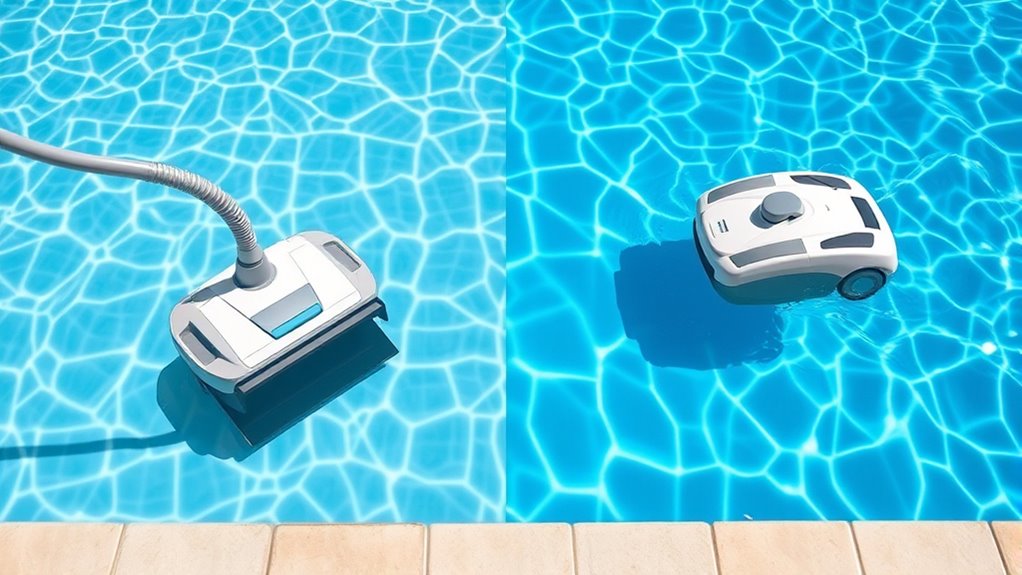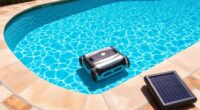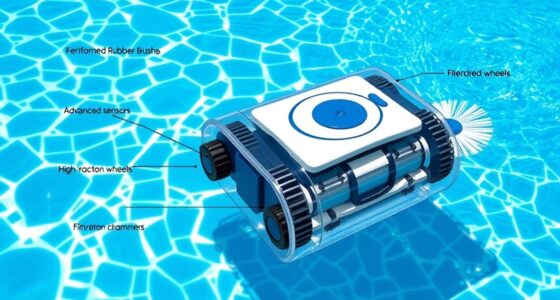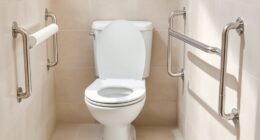Suction pool cleaners rely on your pool’s filtration system and require manual setup to connect to the skimmer or suction line. They are generally affordable and easy to use but may take longer to clean bigger pools and don’t always reach corners and walls thoroughly. Robotic cleaners operate independently with advanced navigation and sensors, providing faster, more thorough coverage with minimal effort. To discover which option best fits your needs, keep exploring the details below.
Key Takeaways
- Robotic cleaners offer autonomous, thorough cleaning with advanced navigation, while suction cleaners rely on pool pump suction and manual setup.
- Robotic units are easier to install, operate independently, and adapt better to various pool shapes and surfaces.
- Suction cleaners are generally less expensive upfront but require more manual intervention and maintenance over time.
- Robotic cleaners consume less energy, have longer durability, and typically provide superior coverage, especially for walls and corners.
- Eco-friendly robotic models use biodegradable materials and energy-efficient design, making them more sustainable than traditional suction cleaners.
How Suction Pool Cleaners Work
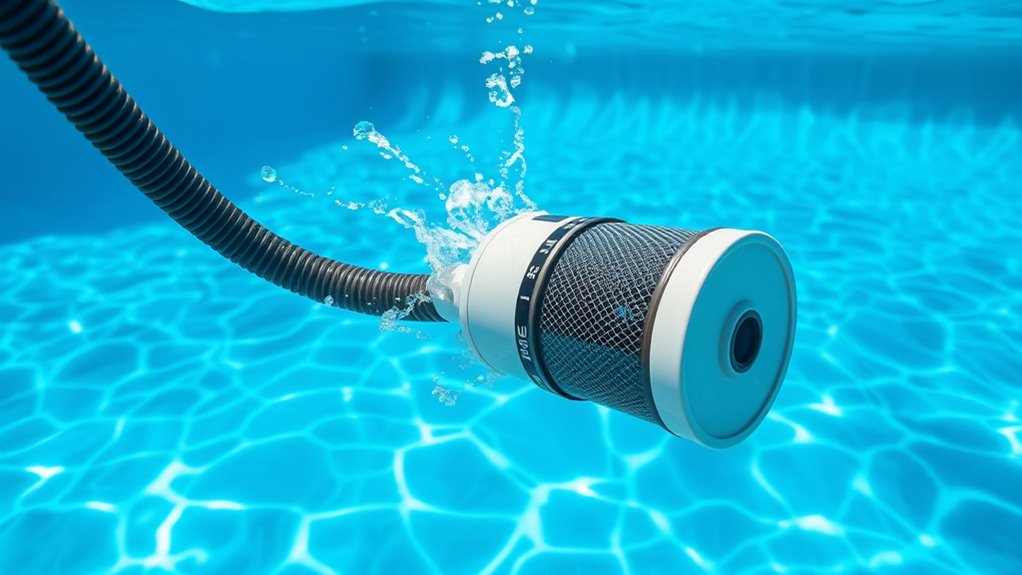
Ever wondered how suction pool cleaners keep your pool spotless? It all comes down to their suction power. These cleaners attach to your skimmer or dedicated suction line, creating a strong vacuum that pulls in debris from the pool floor and walls. The higher the suction power, the more efficiently they pick up dirt and leaves. Inside, a filter basket or fine mesh traps debris, preventing clogs and maintaining ideal flow. The filter capacity determines how much debris it can hold before needing to be emptied, so a larger capacity means less frequent stops. As the cleaner moves along surfaces, it continuously sucks up dirt, keeping your pool crystal clear. This simple but effective system relies on powerful suction and ample filter capacity to do its job. Effective debris removal is also enhanced by regular maintenance and appropriate filter cleaning, which helps sustain optimal system performance and prolongs the lifespan of the cleaner. Additionally, understanding the technology used in these systems can help you choose the most efficient model for your needs.
How Robotic Pool Cleaners Operate
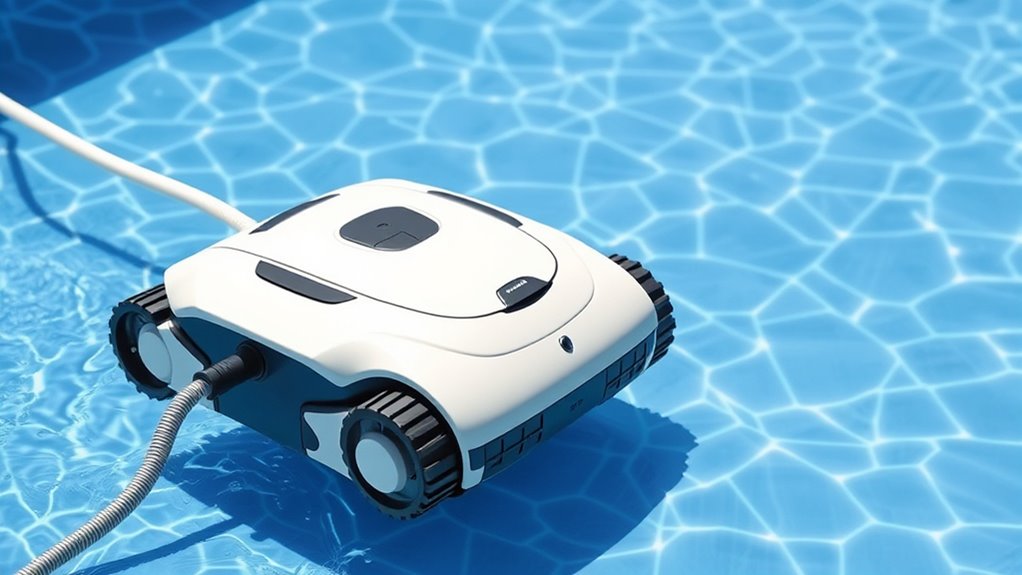
Robotic pool cleaners operate independently using built-in motors and advanced navigation systems. They rely on improved battery technology, allowing for longer cleaning cycles without needing a power cord connection. These cleaners map the pool’s layout and adjust their path to guarantee thorough coverage. Water filtration is a key feature, as they continuously filter and trap debris from the water, keeping your pool cleaner and clearer. The filtration system is often equipped with fine filters to capture dirt, leaves, and even algae. Because they are self-contained, robotic cleaners can operate efficiently with minimal supervision. Their intelligent navigation and powerful filtration make them highly effective at cleaning all pool surfaces, reaching niches and corners that traditional cleaners might miss, ensuring your pool stays pristine with less effort on your part. Additionally, many models feature advanced sensor technology to improve their cleaning efficiency and ensure no area is missed. Regular filter maintenance is crucial for sustaining optimal performance and prolonging the lifespan of the device. Incorporating AI-powered navigation can further enhance their ability to adapt to different pool shapes and obstacles, making cleaning even more comprehensive.
Installation and Setup Processes
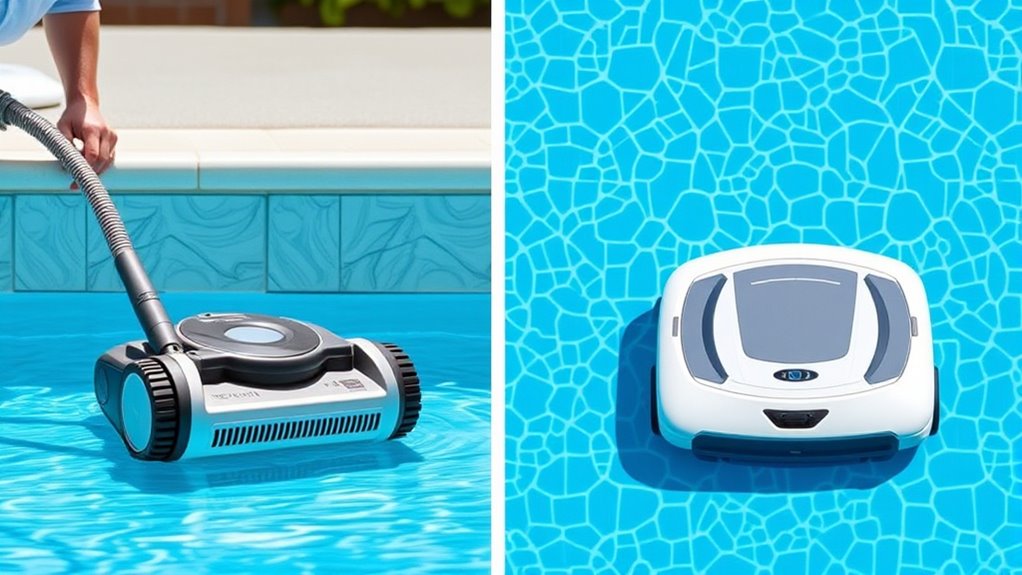
Installing and setting up robotic pool cleaners is straightforward, often requiring minimal tools and time. The installation complexity is low, making it easy for you to get started without extensive technical skills. Most models come with clear instructions and a simple process for connecting power supplies and placing the cleaner in the pool. The user interface is typically intuitive, featuring straightforward controls or mobile app access, so you can customize cleaning modes effortlessly. You won’t need to worry about complicated configurations or extensive setup steps. Once plugged in, you can usually start cleaning with just a press of a button or a tap on your device. Additionally, many models are designed with ergonomic features that enhance ease of use during setup and operation. Some models also include self-adjusting mechanisms to optimize cleaning performance across different pool sizes and shapes, further simplifying the setup process. Modern robotic cleaners often incorporate smart technology, allowing for more efficient and adaptable cleaning routines to meet your pool’s unique needs. Furthermore, many units are compatible with smart home integration, enabling remote control and scheduling for added convenience. Incorporating user-friendly design elements can also help make the setup even more effortless.
Cleaning Efficiency and Effectiveness
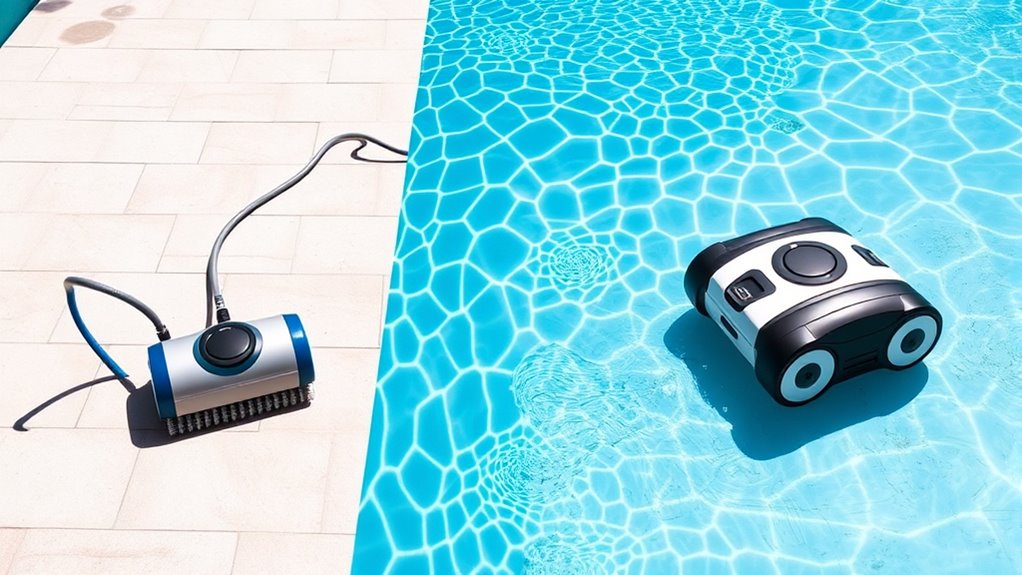
When it comes to cleaning efficiency, you’ll notice differences in dirt removal speed and how thoroughly each type covers your pool. Robotic cleaners often reach all areas more consistently, including corners and walls, thanks to their advanced navigation. Suction cleaners can be effective but may take longer to clean deeply, especially in larger pools. Additionally, understanding regional availability of local resources and tools can help you choose the best equipment suited for your specific pool environment. Optimizing tuning software settings can further enhance the performance and efficiency of robotic pool cleaners in some models. Furthermore, evaluating navigation technology can provide insight into how well a robotic cleaner adapts to complex pool shapes for optimal coverage. Incorporating advanced sensors can improve a robotic cleaner’s ability to detect dirt and obstacles, leading to more comprehensive cleaning results. For example, integrating sensor-based navigation helps robotic cleaners efficiently map and clean irregularly shaped pools.
Dirt Removal Speed
Dirt removal speed is a key factor in determining how efficiently a pool cleaner can keep your pool spotless. Your cleaning pace impacts how quickly debris is removed, reducing the risk of buildup. Robotic cleaners typically have a faster dirt removal speed, allowing them to cover the pool surface more promptly. In contrast, suction pool cleaners may be slower but are effective for specific debris types. Additionally, the versatility of a cleaner influences its ability to handle various debris and surfaces effectively. A powerful motor also contributes significantly to cleaning speed by enabling more robust suction and agitation. | Feature | Impact on Cleaning Pace |
| ———————— | ————————————- |
|---|---|
| Motor Power | Higher power = faster dirt removal |
| Navigation System | Better coverage = quicker cleaning |
Robotic cleaners are often more efficient in maintaining a brisk cleaning pace, but your choice depends on your pool’s size and debris type. Speed enhances overall cleanliness and reduces pool maintenance time.
Coverage Area Scope
Coverage area is a key factor that determines how thoroughly your pool gets cleaned. Your pool’s size directly impacts the coverage area of your cleaner. Suction pool cleaners typically have a limited coverage area, making them more suitable for small to medium pools. They often require manual repositioning to cover the entire surface, which can affect cleaning efficiency. Robotic pool cleaners, on the other hand, usually boast a larger coverage area thanks to advanced navigation systems, allowing them to automatically clean larger pools more effectively. Their ability to map and adapt to different pool sizes ensures extensive coverage without constant supervision. If you have a bigger pool, a robotic cleaner’s extensive coverage area will save you time and ensure every inch gets cleaned thoroughly. Additionally, the coverage area scope of a cleaner can influence how often you need to perform maintenance or empty the filter, impacting overall convenience. Moreover, robotic cleaners often incorporate smart navigation technology, enabling them to optimize their cleaning paths and reduce missed spots. The integration of pool size considerations into cleaner selection can further enhance cleaning performance and efficiency.
Deep Cleaning Ability
Robotic pool cleaners typically deliver superior cleaning efficiency because they are equipped with advanced brushes, scrubbing pads, and powerful suction systems that target dirt, algae, and debris more thoroughly. Their deep-cleaning ability is especially noticeable in larger pool sizes, where manual or basic cleaners might miss spots. They adapt well to varying water chemistry conditions, maintaining ideal cleaning performance regardless of pH levels or chemical balance. These cleaners systematically cover the pool floor, walls, and steps, ensuring thorough dirt removal. Unlike suction pool cleaners, which may struggle with complex water chemistry or larger pools, robotic cleaners excel at deep cleaning, providing consistent, effective results that keep your pool sparkling and hygienic. Additionally, their programmable features allow for customized cleaning schedules, optimizing their performance and efficiency. Modern robotic cleaners also incorporate noise reduction technology, making them quieter during operation and enhancing user experience. Moreover, their ability to adapt to changing pool conditions ensures reliable cleaning regardless of environmental factors. They often include filter systems that are easy to clean and maintain, further improving their overall cleaning depth and effectiveness.
Energy Consumption and Cost Considerations
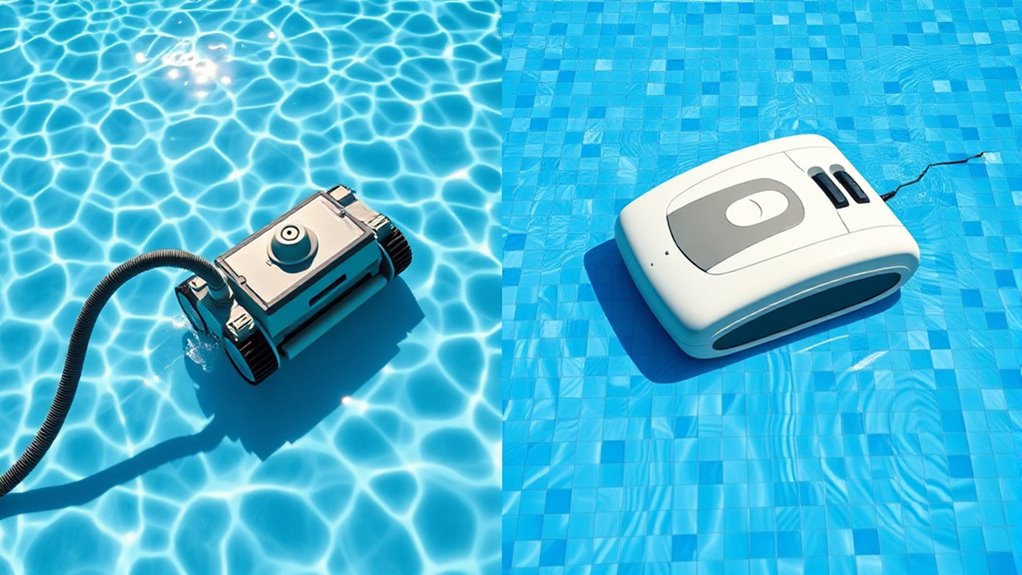
When comparing suction and robotic pool cleaners, you’ll notice differences in energy efficiency that can impact your electricity bills. Operating costs can vary widely based on the cleaner’s design and power consumption. Understanding these variations helps you choose a more cost-effective and energy-efficient option for your pool.
Energy Efficiency Differences
Although both suction and robotic pool cleaners are designed to keep your pool tidy, they differ considerably in energy consumption and ongoing costs. Robotic cleaners typically have lower power consumption, leading to better energy savings over time. Suction models often rely on your pool’s pump, which increases overall energy use. To illustrate, consider this comparison:
| Cleaner Type | Power Consumption | Cost Efficiency | Maintenance Needs |
|---|---|---|---|
| Suction | Higher | Moderate | Moderate |
| Robotic | Lower | High | Lower |
Robotic cleaners are generally more energy-efficient, helping you save on electricity bills. Their optimized motors and independent operation make them a smart choice for reducing energy costs in the long run.
Operational Cost Variations
Operational costs for pool cleaners vary considerably based on their energy use and maintenance needs. When doing a cost comparison, consider how much energy each model consumes, as this impacts your monthly expenses. Robotic pool cleaners typically offer better energy savings because they are designed to run efficiently and often use less power than suction models. Suction cleaners, on the other hand, may consume more energy due to their continuous operation and reliance on pool pump power. Maintenance costs also influence overall expenses; robotic cleaners usually require less frequent repairs and filter changes. By evaluating energy consumption and maintenance needs, you can make an informed decision that minimizes operational costs and maximizes your pool cleaning efficiency over time.
Maintenance and Durability
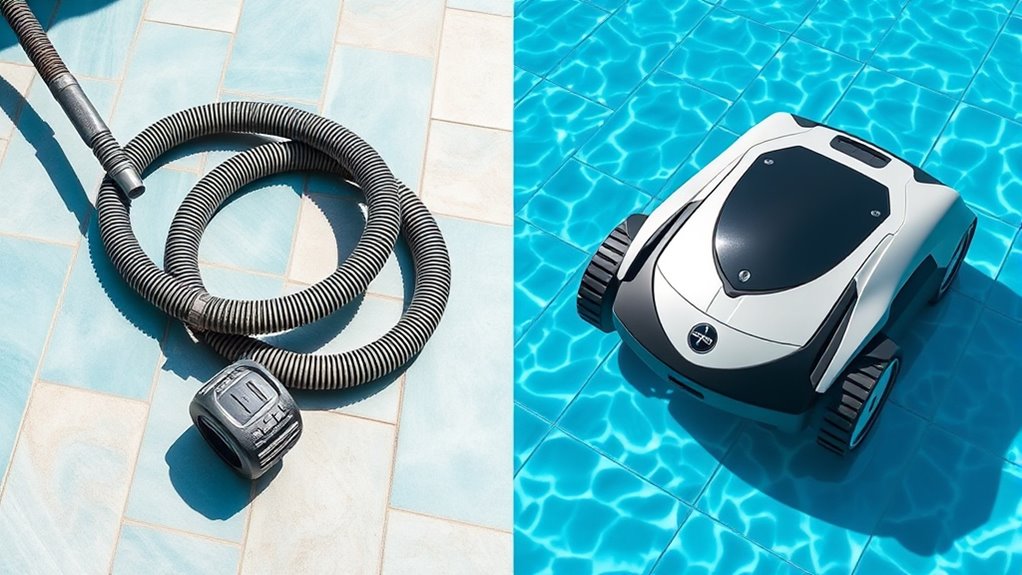
Maintenance and durability are key factors to contemplate when choosing between suction pool cleaners and robotic pool cleaners. Suction cleaners typically require regular filter maintenance to keep debris from clogging the system, which can be straightforward but needs consistent attention. Robotic cleaners usually feature sealed motors designed for robustness, often lasting longer with proper care. The motor durability of robotic models means fewer repairs over time, making them a reliable long-term investment. In contrast, suction cleaners have simpler parts that are easier to replace but may wear out faster under heavy use. Overall, robotic pool cleaners tend to offer greater durability and less frequent maintenance, but both require some upkeep to ensure ideal performance and longevity.
Ease of Use and User Experience
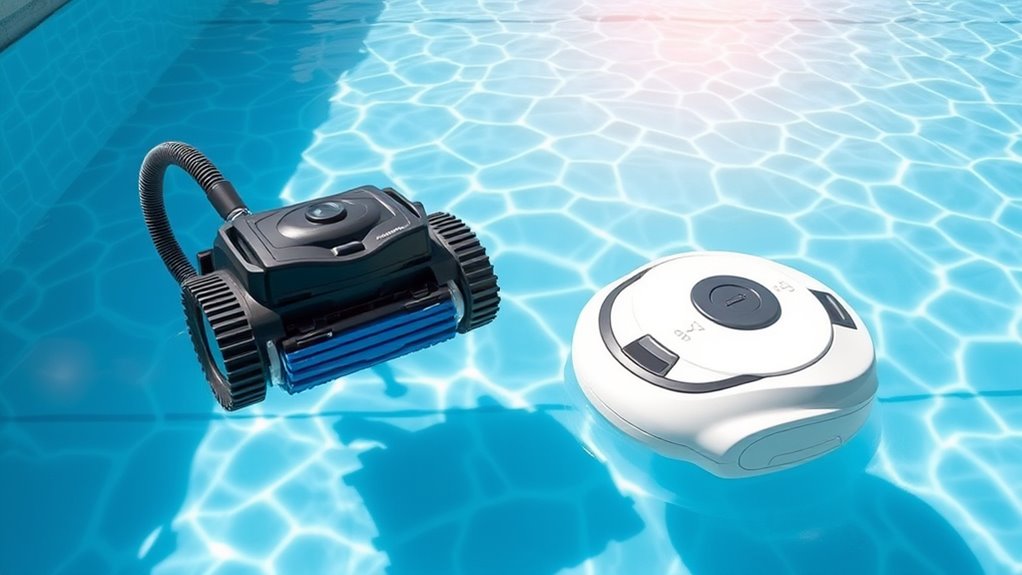
When choosing a pool cleaner, ease of use makes a big difference in your experience. Some models are straightforward to set up and operate, while others require more effort or technical know-how. Understanding these differences helps you select a cleaner that fits your comfort level and daily routine.
Ease of Use Differences
Robotic pool cleaners generally offer a more user-friendly experience, often featuring intuitive controls and minimal setup requirements. You won’t need to worry about manual operation or complex adjustments. Instead, you can simply use the remote control to direct the cleaner or set it to run automatically. This ease of use makes robotic models ideal for busy schedules. Here are some key differences:
- Robotic cleaners often operate with minimal manual intervention.
- They typically include a remote control for easy navigation.
- Setup is quick and straightforward, unlike suction cleaners needing more manual adjustments.
- Many models allow scheduling, reducing the need for manual operation during cleaning.
Setup and Operation Simplicity
Setting up and operating robotic pool cleaners is typically simpler than with suction models, thanks to their intuitive design. With robotic cleaners, you usually just place them in the pool, power them on, and let them work. Many models come with remote control options, allowing you to start, pause, or schedule cleaning sessions easily from a distance. Unlike suction cleaners, which often require manual operation and connection to pool skimmers or hoses, robotic units are mostly plug-and-play. Their user-friendly interfaces and minimal setup make them ideal for quick deployment. Overall, robotic pool cleaners offer a straightforward experience, reducing the need for manual operation and making pool maintenance more convenient and less time-consuming.
Price Range and Long-term Investment
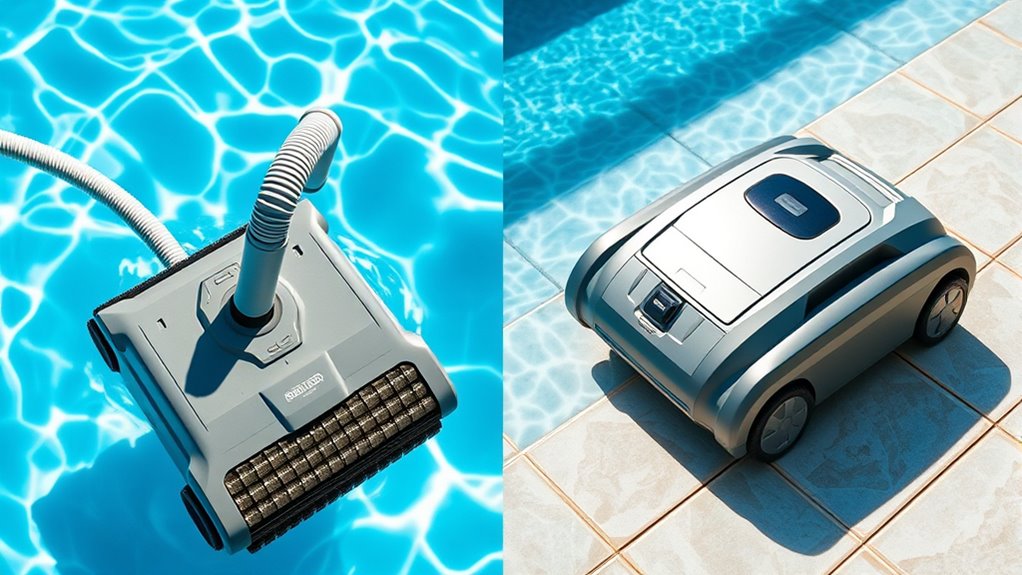
Suction pool cleaners typically cost between $100 and $400, making them an affordable option for many homeowners. While initial prices are lower, you should consider long-term investment factors. Your choice depends on the brand reputation and pricing strategies, which influence durability and performance.
To help decide, keep in mind:
- Lower upfront costs may lead to higher maintenance over time.
- Trusted brands often offer better warranties and support, saving money long-term.
- Robotic cleaners, although pricier initially, tend to be more energy-efficient.
- Investing in quality can reduce replacement costs and improve cleaning effectiveness.
Balancing initial expense with durability and efficiency ensures your pool stays clean without draining your budget over time.
Compatibility With Different Pool Types
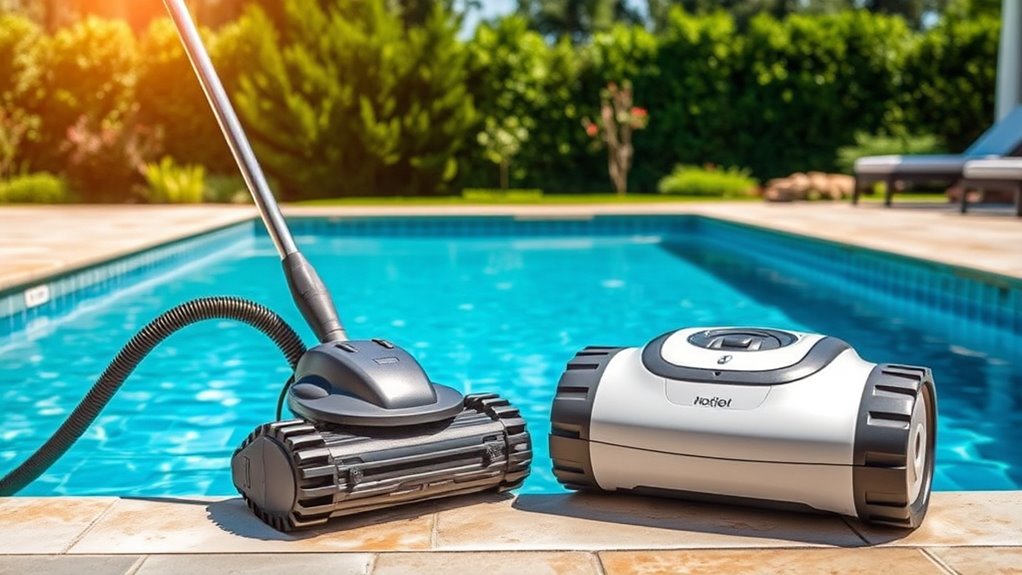
Choosing a pool cleaner that works well with your specific pool type is essential for effective cleaning. Suction cleaners are typically compatible with various pool surfaces, but installation flexibility can vary based on pool shape and filtration setup. Robotic cleaners often adapt easily to different pool surfaces and are more versatile regarding installation.
| Pool Type | Compatibility & Installation Flexibility |
|---|---|
| Concrete | Suction: Good; Robotic: Excellent |
| Vinyl | Suction: Good; Robotic: Excellent |
| Fiberglass | Suction: Moderate; Robotic: Excellent |
| Gunite | Suction: Good; Robotic: Excellent |
| Above-ground | Suction: Limited; Robotic: Highly flexible |
Environmental Impact and Sustainability
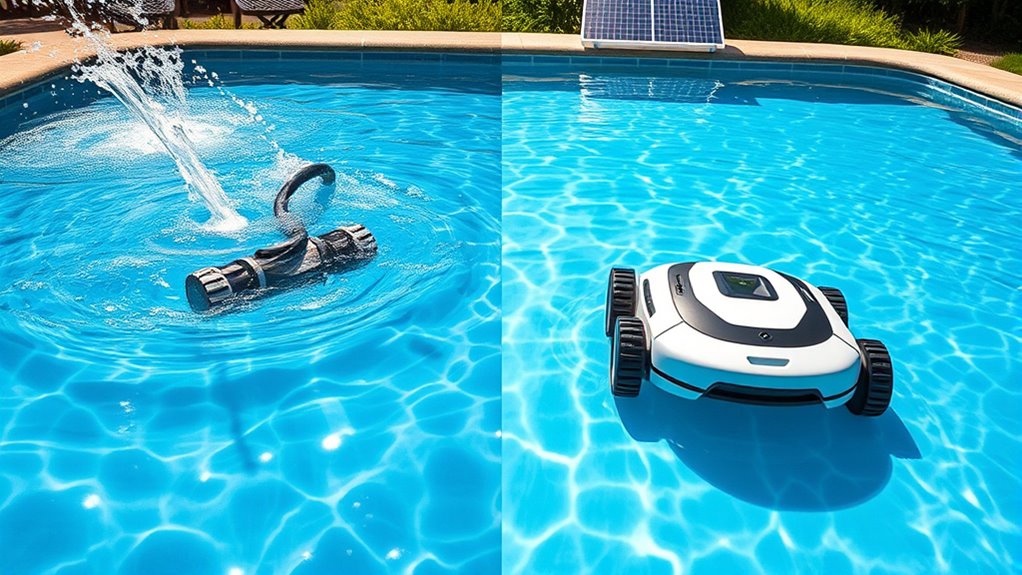
When evaluating pool cleaners, considering their environmental impact and sustainability is essential, as these factors influence both ecological health and long-term costs. Robotic and suction cleaners differ in how eco-friendly they are, especially regarding materials used. Look for models made from eco friendly materials and biodegradable components to reduce waste. To help you decide, consider these points:
- Use of biodegradable components minimizes landfill waste.
- Eco friendly materials reduce the carbon footprint during manufacturing.
- Energy-efficient models lower electricity consumption.
- Longer-lasting devices decrease frequent replacements, reducing waste.
Choosing a cleaner with these features supports sustainability and reduces your environmental impact, making your pool maintenance more eco-conscious.
Frequently Asked Questions
Which Cleaner Is Better for Above-Ground Pools?
When choosing a cleaner for your above-ground pool, consider your pool maintenance needs and cleaning efficiency. A robotic cleaner offers automated, thorough cleaning with minimal effort, making it ideal for regular maintenance. Suction pool cleaners can be effective but may require more manual adjustment and effort. For ease and consistent cleaning, a robotic cleaner is often better. However, your specific pool size and budget also influence the best choice.
Can Robotic Cleaners Clean Pool Walls Effectively?
Robotic cleaners can clean pool walls effectively, saving you manual operation and reducing the need for chemical cleaning. They use advanced brushes and navigation systems to reach and scrub surfaces thoroughly. Unlike manual scrubbing, robotic cleaners automate wall cleaning, ensuring your pool stays spotless with minimal effort. This makes them a smart choice for maintaining clean walls effortlessly, especially if you want consistent, hands-free cleaning.
Are Suction Cleaners Suitable for Large or Complex Pools?
If you have a large or complex pool, suction cleaners might struggle with the pool size and complexity. They often take longer to cover extensive areas and can miss spots in intricate shapes or with many obstacles. For ideal cleaning, you should consider your pool’s size and complexity, as robotic cleaners tend to perform better in these scenarios. They adapt more easily to various pool designs and ensure thorough cleaning.
How Do Cleaners Handle Debris Like Leaves and Twigs?
You’ll find that most pool cleaners handle debris like leaves and twigs effectively, especially if they have strong suction power. They excel at leaf pickup and twig removal, ensuring your pool stays clean. For larger debris, you might need to empty the filter basket more often. Regular maintenance keeps these cleaners working efficiently, so your pool remains inviting and free of clutter after storms or heavy use.
Do Robotic Cleaners Require Wi-Fi or App Connectivity?
Think of robotic cleaners like smart assistants—they often need Wi-Fi connectivity and app integration to function smoothly. Without these, you might miss out on remote control, scheduling, or troubleshooting features. Many models rely on Wi-Fi to connect to your smartphone, making pool maintenance easier and more efficient. If you prefer a hands-free experience, look for a robotic cleaner that offers app integration for seamless operation and peace of mind.
Conclusion
Choosing between suction and robotic pool cleaners is like selecting your hero—each has its strengths. Think of suction cleaners as the dependable old guard, while robotic cleaners are the futuristic innovators. Consider your pool’s size, your budget, and how hands-on you want to be. Whichever you pick, remember, the right cleaner transforms your pool from a dreaded chore into a shimmering oasis—like a modern-day Poseidon wielding his trident for effortless beauty.
